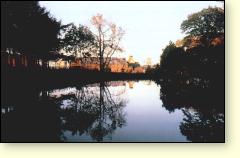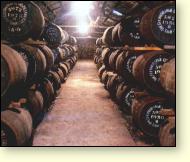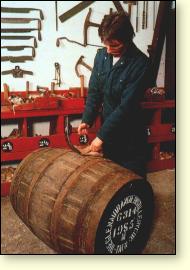
 |
|
Location: Tain, Ross-shire IV19 1PZ
Roads: A9, signposted just north of Tain
Hours: Tours 10.30am and 2.30pm, Tues, Wed & Thurs
All visits by appointment · Group bookings, max 10
No reception centre or shop
Phone: 01862-892043
Fax: 01862-393862
Homepage: www.glenmorangie.com/
|
Text from The Whisky Trails, Copyright © Gordon Brown 1993:
Glenmorangie is the best-selling malt whisky in Scotland and the distillery that makes it sits at the bottom of a slope on the shore of the Dornoch Firth. The setting is very much a little ‘glen of tranquillity’, as the translation from the Gaelic describes it. Glenmorangie is close to the Royal Burgh of Tain, one of Scotland’s oldest towns and long a place of pilgrimage due to its being the birthplace of St Duthus around the year 1000 AD.
Assorted buildings climb the slope above the warehouses at the water’s edge and in summer stone-built distillery cottages are smothered in flowers. A waterwheel that used to supply all the power is still in place. The staff comprises the ‘Sixteen Men of Tain’ who make the whisky and they are featured in the company’s advertising; all are local celebrities. A recently retired manager had worked at the distillery for 40 years and his father for 70 years before him.
Documentation about distilling at the old Morangie farmhouse goes back at least 250 years to the 1730s, but the licensed activity began in 1843 with the conversion of a brewery by William Mathieson. By the 1880s the distillery was very run down and new owners completely rebuilt it. The buildings today date from that time although a further internal rebuilding took place in 1979, including the installation of two more stills.
The water at Glenmorangie is hard and 100 years old by the time it bubbles up in the Tarlogie Springs, which can be visited in the adjacent woodland. Before modern filtration systems were installed, limescale had to be laboriously chipped away from the inside of the boilers during the summer months, when the distillery was closed. The company have safeguarded future water supply by buying the springs and surrounding land.
Glenmorangie is effectively produced entirely for bottling as a single malt, but some is used for blending in certain of the company’s own brands. The old-style warehouses have earthen floors, which absorb moisture in wet weather and humidify the air around the casks during the hot summer weather.
Glenmorangie was the first distillery in Scotland to use steam to heat the stills instead of the customary coal fires, which often caused off-flavours through scorching. Eight stills (four pairs) are in place now, including two each from the years 1977, 1980 and 1990. Pot stills have a lifespan of about 15 years and when replaced exact copies must be supplied to avoid the risk of altering the nature of the spirit. Glenmorangie’s are the tallest in Scotland (almost 17 feet), which is an important factor in creating the whisky’s elegant house style. Also contributory to this is the ‘boil pot’ each of them has – a bulge below the neck of the still which ensures that only the lightest, finest alcohols pass over in distillation.

All barrels in the warehouse are re-used; mosth come from the american bourbon trade.
|
In an on-going comparative study, a cask of bourbon whiskey from the Maker’s Mark distillery in Kentucky, USA, is maturing at Glenmorangie to see how the spirit ages in the cooler, damper atmosphere. An equivalent cask of Glenmorangie is undergoing maturation in the hothouse warehouse at Maker’s Mark.
Glenmorangie has recently introduced a Wood Finishes range. The whisky is matured in its traditional barrels but then finished for up to two years in Port wood, Maderia wood or Sherry wood.
Glen Morangie has recently introduced a Wood Finishes range. The Whiskey is matured in its traditional barrels but then finished for up to two years in Port wood, Maderia wood or sherry wood.
The Whisky
Text from The Whisky Trails, Copyright © Gordon Brown 1993:

A cooper at Glenmorangie fits a bung, using sackcloth to give a perfect fit.
|
Glenmorangie uses only American ex-Bourbon oak for maturation of its whisky, all barrels being discarded after the third refill stage. This is one of the few Scotch malts that uses no sherrywood whatsoever in the maturation of its main style. It is deliberate due to the fact that Glenmorangie whisky, although complex, is very subtle. A French parfumier detected 26 distinct aromas in the spirit, enhancing elements that Glenmorangie prefer to cherish and foster rather than mask with sherry-aging. This does not prevent the distillery finishing off certain older special edition bottlings with some months in sherry casks since more mature spirit is a little more assertive. The standard whisky is 10 years old at 40% vol. It is delicate, fruity and flowery with some sweetness and bite. The Glenmorangie Natural cask strength is the same age but about 59% vol.-it tends to have a fuller, nuttier, spicier flavour. The 18-year-old at 43% vol. is rounder in texture with vanilla, honey and caramel from time spent in small oak casks.
Source of water
Tarlogie Springs
Of interest
Text from The Whisky Trails, Copyright © Gordon Brown 1993:
· The Poor House at Tain dates from the 1840s. Under the Poor Law Act, parishes had to provide for the needy but often the places were so austere that paupers turned down the offer of admission tickets. Potatoes, oatmeal and vegetables – never meat – made up the staple diet; nowadays all these foods have come to be highly regarded by nutritionists.
· Cheesemakers at Blairliath in Tain welcome visitors. These are free tastings and conducted tours.